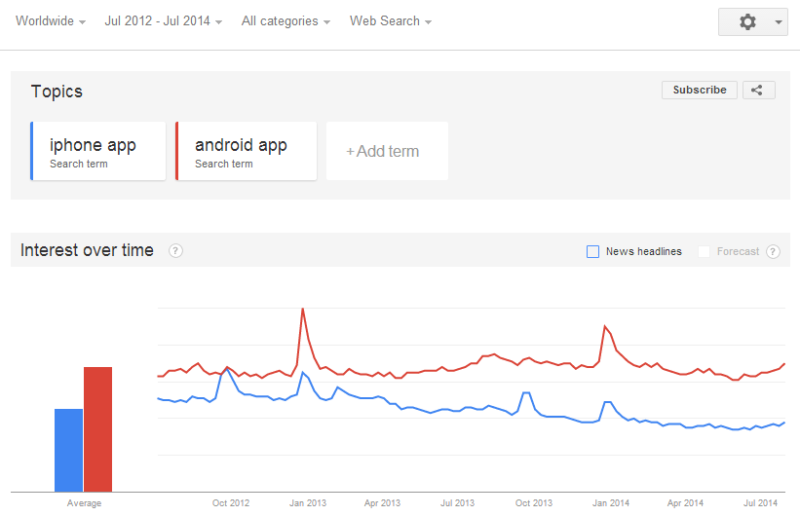Have You Done These 5 App Store Optimizations?
App Store Optimization is the new Search Engine Optimization. Try these suggestions from contributor Ashley Kemper and get off to a great start.
App Store Optimization (ASO), while still a relatively new venture for many marketers, is one of the best ways to promote a new or existing app on a lean budget.
The first and most critical component to ASO, of course, is developing a phenomenal product that people will not only want to use, but will want to share and evangelize on your behalf.
Completing basic ASO will give your app a fighting chance to succeed in the app marketplace, but achieving Flappy Bird or 2048 levels of success mandates a product that is useful, addictive, or both.
1. Optimize Your Desktop Website To Rank For App-Related Keywords
Focusing app marketing effort into a desktop site may seem counter-intuitive, but online search volume for “app” keywords (especially Android-related searches) has seen stable interest over the past two years:
2. Include App Call-To-Action On Your Website
Whether you are able to achieve organic “app” rankings, or simply have steady levels of inbound traffic, converting those visits into app users should be a prime objective of your desktop site. For businesses where an app is the primary revenue driver, links to the App Store and Google Play store should be highly visible throughout the site.
But even websites that only offer a simple companion app can prioritize this point of engagement by including an app features page on the site and offering a feature that will text users a download link if they enter their phone number. This “text me a link” feature may seem complex, but can actually be achieved with relative ease using Twilio’s Mobile App Distribution product.
3. In-Store App Optimization
Fortunately for SEOs, many standard elements of optimizing a web page can be directly translated to the in-store optimization of an app. While the App Store and Google Play have slightly differing app ranking factors, there are a few key elements regardless of the platform:
- Title: The key to an optimized title is keeping it short, punchy, and relevant. Start off with your app’s brand name, and if it doesn’t already contain a desirable keyword, append a hyphen and at most one keyword that would describe the app. For example: “City Sprinkles – Cupcake Finder.”
- Description: Again, the name of the game is keeping your description short and to the point. Users viewing your app description on a mobile device will see at most a few lines of text before they have to click to view more. If your app’s appeal can’t be simply described in a sentence or two, it might be time to go back to the drawing board and rethink your messaging.
- Logo: Having a strong, eye-catching icon for your app will not only drive initial product views, but may also increase app engagement post-download as a user is scrolling through his or her device. Bold colors paired with simple typography or chunky icons remain easily visible even at the smallest app sizes.
- Type/Category: Placing your app into one or more appropriate categories will improve discoverability among users who browse for apps rather than search for specifics. A Forrester study of European app users showed that 58% of Android users and 63% of iOS users use “general browsing” of the App Store and Google Play to discover new apps.
4. Update App Screenshots
Every app update is an opportunity to also upload fresh screenshots of app interfaces. This frequently forgotten step means that potential users are stuck viewing app 1.0 screenshots when the updated version might be much more polished. The App Store and Google Play allow multiple screenshots, up to 5 and 8, respectively, with additional allowed for tablet app versions.
While these screenshots are best utilized by detailing key interaction points throughout the app, there are no mandates that these images be literal screenshots. Stylized representations of app functionality (that still provide an honest view of the app experience) may be better served to communicate more intricate functionality of complex apps.
5. Install App Rating System
Possibly the most effective way to increase app rankings is to amass positive rankings from existing app users. A study by Appurify showed that of the top one thousand ranked apps in the Apple App Store, more than half (51.1%) had at least a 4.5 star rating.
Rather than attempt independent outreach efforts to provoke app ratings from users, there are many services available that simplify the in-app ratings prompt. Both Apptentive and Localytics offer platforms for both data collection and user prompts to drive app ratings.
Final Thoughts
While these simple optimizations can be applied to existing apps, it is most ideal to complete optimization efforts during the initial app design and development project in order to launch with your best foot forward.
Have other app optimization tips? Leave them in the comments below or tweet to @theashleykemper!
(Stock image via Shutterstock.com. Used under license.)
Opinions expressed in this article are those of the guest author and not necessarily MarTech. Staff authors are listed here.
Related stories

